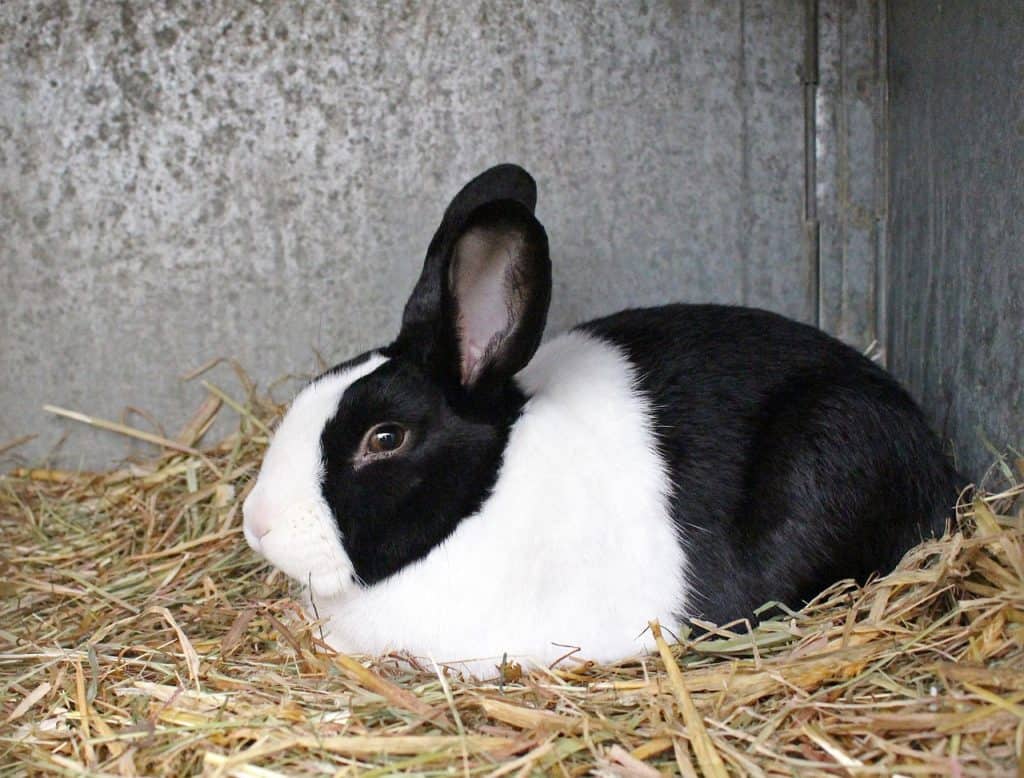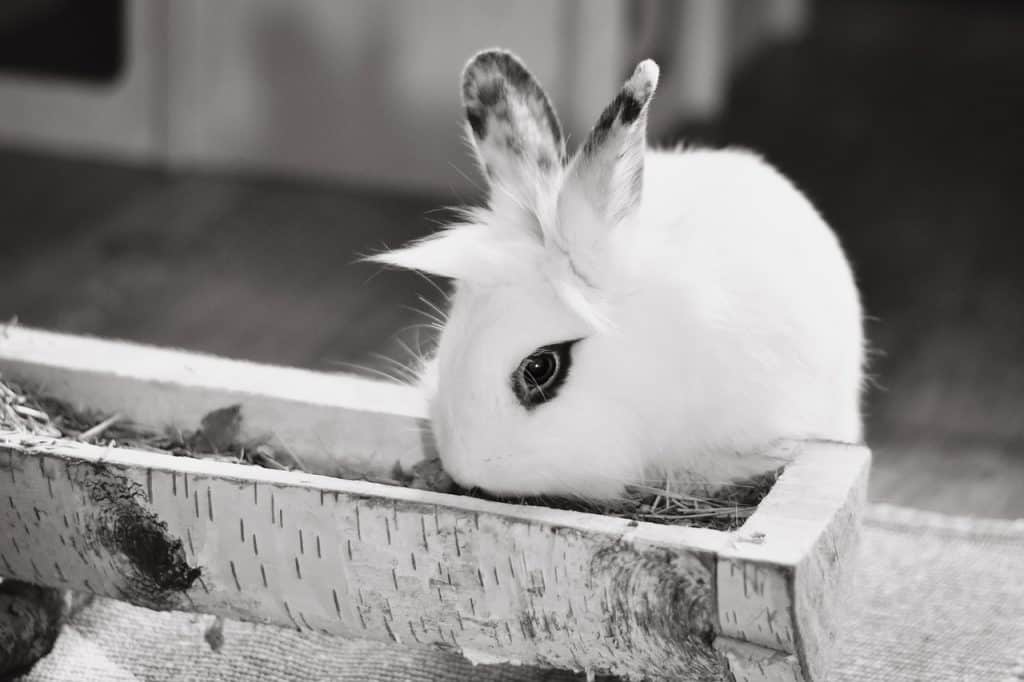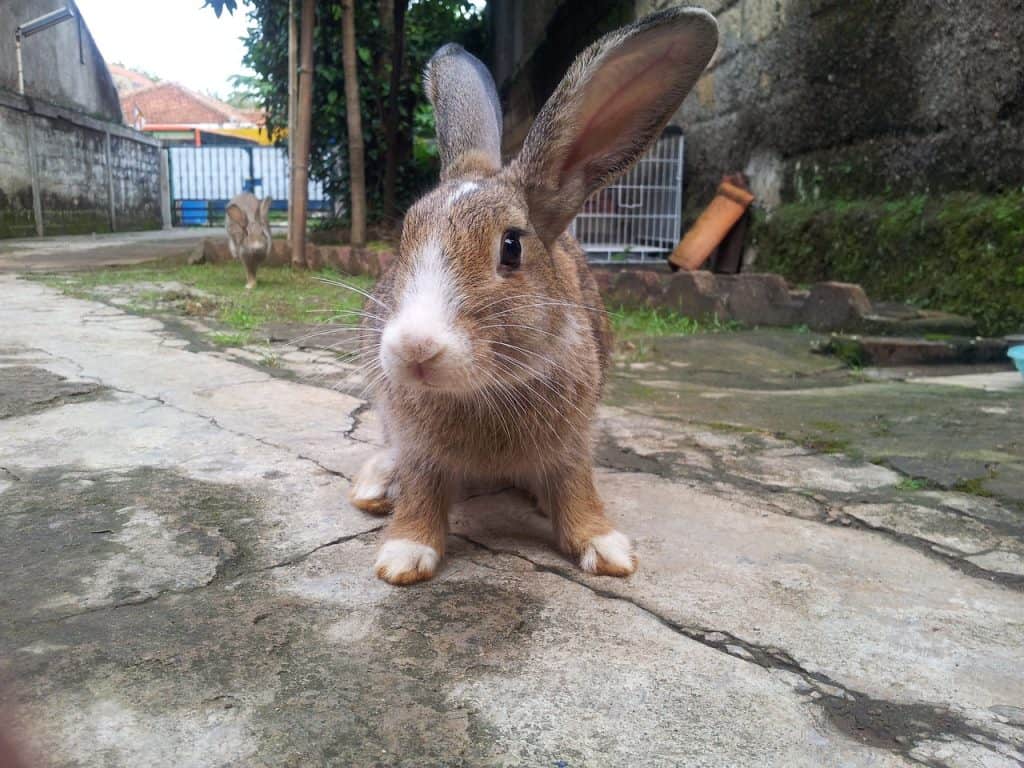
The prodigious history of rabbit breeding has produced a fascinating array of color combinations.
Sometimes, this has been deliberate: The Havana, Lilac, Thrianta, and Harlequin are just a few examples of rabbits that were specially bred for their colors. When shown professionally, these rabbits are closely scrutinized for the fineness of their coloration.
Other times, the coloring occurs quite an by accident, or as a result of considerable interbreeding: The Lop, Angora, and Rex families all owe their variety of colors to the breeding necessary to achieve other desirable characteristics. In these cases, the colors may be a fantastic side benefit to prospective pet owners.
Either way, you look at it, coloration is a big part of what makes rabbit breeds so intriguing. Today, we will look at each breed recognized by the American Rabbit Breeders Association that shows both black and white in its coat. No need to wait any longer, let’s jump right in!
1. American Fuzzy Lop

If you’re ever looking for a particular color of rabbit, chances are the Lop family has it! In this instance, American Fuzzy Lops in the “pointed white” coloration group can be found with black markings on their noses, feet, and tails. Often weighing less than 4 pounds, they are especially well suited to homes that don’t have much space to accommodate a cage.
2. Blanc de Hotot

With its distinctive “eyeliner” look, the pleasantly robust Blanc de Hotot has a striking black-and-white contrast. One of the rarer breeds of rabbits still in existence today, the Blanc de Hotot got its start in early 1900s France as a descendant of the now-disused Giant Papillon. Their dense, fine fur is especially luxurious to pet.
3. Britannia Petite

A mini breed with a prominent posture, the black and white speckled Britannia Petite is notable as being the only small rabbit (under 4 pounds) with an arch reminiscent of wild hares. Their plucky attitude and vibrant energy make them popular amongst pet owners who prefer an active pet.
4. Californian
The medium-sized Californian is one of only a few breeds that are black and white by default. Their pure white bodies are accented by almost black noses, feet, tails, and ears. It is nearly twice as large as the breed most similar in appearance, the Himalayan.
5. Checkered Giant

Usually weighing between 11 and 16 pounds, the Checkered Giant is a larger-than-life rabbit with distinctive black and white coloration as well as a high arch. With its raised belly and prominent black markings on the ears, snout, and spine, this big bunny is unmistakable in a lineup.
6. Dutch

These small (but not miniature) rabbits are well-known for their unique coloration, sometimes referred to simply as “Dutch markings”. With a white face and matching white saddle, when found with black as their complementary color they can appear to be wearing a mask!
7. Dwarf Hotot

Sporting the same black eyeliner as the Blanc de Hotot, these miniaturized versions of the once-popular French rabbit have faired much better in the American market than their larger brethren. Because of their small size, they are sometimes favored as pets in houses with limited space.
8. English Angora

As the smallest of the Angora breeds, the English Angora also carries the distinction of being the most difficult to groom; its hair tends to mat easily. Better for experienced rabbit owners, the English Angora can be seen with a unique black, white, and grey color scheme that is sure to draw admiration from onlookers.
9. English Lop

The largest of the Lop breeds, the English Lop is most easily recognized by its incredibly oversized ears. Look for one in the “pointed white” color group to find a combination of black and white in its coat.
10. English Spot
A stereotypically black and white rabbit, the English Spot sports the lithe body style of a hare. Their distinctive black shoulder markings differentiate them from the Rhinelander and Checkered Giant, two other spotted breeds.
11. French Angora
Among the Angora family, the French Angora may look most individual and special with a black and white coat. Because it lacks the furry face of other Angoras, the color contrast can be seen more vividly.
12. French Lop

Nearly as large as the English Lop, but without the comically oversized ears, French Lops make excellent house pets. Their wide palette of colors includes a variety of black-and-white combinations.
13. Harlequin

Harlequins are especially prized for their unique color combinations. Look for one in the “magpie group” of colorings to find one whose face will be divided between black and white, resembling its namesake character’s mask.
14. Havana
Though perhaps best known for its all-black coloring, the Havana is also available with a broken black and white coat. Their compact bodies and kindhearted demeanors make them popular house pets.
15. Himalayan

Often recommended as a suitable rabbit for complete novices, the Himalayan is readily available in a sharp black-and-white contrast color scheme. Possessed an easygoing attitude, they feel at home in just about any environment.
16. Holland Lop

These scrunched-up balls of fluff have lovely energy about them and are generally regarded as fantastic pets. What they lack in size, they make up for in personality and wide availability of interesting coat patterns.
17. Jersey Wooly

Combining the best of the extra-fluffy Angora family with the manageable coat of Chinchillas and tiny stature of Netherland Dwarves, Jersey Woolies are a favorite of pet owners who want a fuzzy breed without as much upkeep. In their black and white coloration, they can display stark contrast between the fur on their face and the rest of their coat.
18. Lionhead

Proudly displaying a fluffy mane akin to their namesake, the Lionhead is particularly handsome when found in black and white. Especially prized when the body and mane are seen in contrasting colors.
19. Mini Lop

Though larger than the Holland Lop, the Mini Lop has many of the same color combinations available to choose from. Look for those in the “broken” or “pointed white” color groups.
20. Mini Rex

With a characteristically rich and velvety coat, the Mini Rex can be found in a variety of color configurations combining black and white. The broken has been said to resemble the color pattern and texture of a Jersey cow.
21. Netherland Dwarf

Look especially for the “Black Otter” coloring, a unique black and white pattern found almost exclusively in this spunky little breed.
22. Polish

Coming mainly from solid colors, the slight of build Polish rabbit is most often found in solid colors. Search out a “broken” rabbit for the possibility of a black and white coat.
23. Rex

Larger and more robust than its miniature progeny, the Rex has all the same desirable characteristics in its coat. It is one of the very few breeds available in the “Black Otter” coloring.
24. Satin

Known especially for the luster of their coats, the Satin is the unwitting descendent of a Havana breeding program. They are commonly seen in black with white accents or vice versa.
25. Satin Angora
This high-maintenance, amazingly soft, and silky breed has the benefit of distinctive color contrast between its face and coat – perfect for showcasing a black-and-white combination.
26. Silver Marten
The offspring of a Chinchilla and a Tan, the Silver Marten always sports a stylish white accent over the color of its base coat.
Conclusion
Plenty of rabbit breeds have been, purposely or not, developed to offer a black-and-white color scheme. We hope that this guide has helped you to narrow down your choices and find the perfect black-and-white rabbit for your life!
How can I identify what kind of rabbit I have?
To establish the breed of your rabbit, pay great attention to its body form, size, ear set, and general coloration. Some rabbit breeds may be identified by the texture of their fur and unique characteristics.
What is the most unusual type of rabbit?
The netscheri rabbit is said to be the world’s rarest.
Why is my black rabbit turning white?
During the summer, a rabbit’s fur will be darker. As the days become shorter in the winter, less melanin is generated. As a result, a rabbit’s new coat will be devoid of color. It’s pretty typical for a rabbit’s fur to turn totally white in snowy climates.
Which rabbit breed is the easiest to train?
Mini Lops, possibly the most popular breed in the world, are widely sold or produced as pets and show rabbits. They are little with floppy ears, similar to Holland Lops. They are highly joyful and lively, and they are quite easy to teach. Mini Lops are ideal for anybody seeking a litter-trained rabbit.
Can two broken rabbits be bred?
When you breed a broken patterned rabbit to another broken, you have a 25% chance of getting a solid, a 50% chance of getting a broken, and a 25% chance of getting a Charlie. A Charlie is defined as: The EnEn gene present in a Charlie. It’s simply a patterned broken shattered.
What is the most prevalent rabbit breed?
The Dutch lop. This is without a doubt one of the world’s most popular rabbit breeds. Its appeal stems entirely from its convenient size and the fact that these bunnies are kind and sociable. The Dutch lop dwarf must be able to walk about a lot and must have chew toys.
Do pet rabbits enjoy cuddling?
When approached properly, most rabbits like being caressed and rubbed. Few people enjoy being carried or hugged since being so high off the ground makes them feel uneasy; nevertheless, many people would willingly sit on your lap or snuggle up next to you for a cuddle.
What kind of bunny has white fur with black spots?
Blanc de Hotot is a medium-sized rabbit breed that originated in France. It is a little, thickset white rabbit with black rings around each dark eye. The breed was developed in the early 1900s in Hotot-en-Auge, Normandy, France, and by the 1920s had spread throughout Europe and into North America.